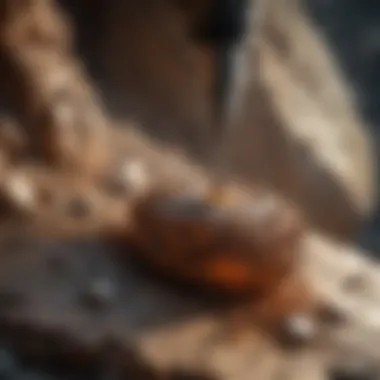The Art of Drilling into Rock: A Detailed Exploration


Rock and Fossil Identification
Understanding the distinguishable characteristics of rocks and fossils is paramount for enthusiasts in geology and rock collection. Before venturing into the intricate process of drilling into rock, one must grasp the diversity present in the geological realm. Various types of rocks, from sedimentary to igneous and metamorphic, each hold unique features waiting to be deciphered. Similarly, fossils offer a window into the past, unveiling the remnants of plants and creatures long extinct. To identify these treasures, collectors must keenly observe specific traits indicative of rock type or fossil origin. Utilizing specialized tools like magnifiers, hardness picks, and UV lights becomes indispensable in discerning these subtle nuances amidst the rugged terrain.
Collecting Tips and Techniques
Embarking on a rock-collecting expedition requires more than just an adventurous spirit; it demands adherence to best practices ensuring a fruitful and safe experience. From scouring maps for prime collecting sites abundant in geological wonders to employing ethical extraction methods, collectors must approach their pursuit with meticulous planning and consideration. Safety measures in specimen extraction play a crucial role in preserving both the environment and the integrity of the collected rocks or fossils. Carefully documenting the location and conditions under which specimens are found can enhance the scientific value of each discovery, enriching the collector's understanding of geological processes intricately entwined with these artifacts of antiquity.
Preservation and Display
Preserving the integrity of collected rocks and fossils marks a crucial phase in the journey of a dedicated collector. Employing specialized techniques like consolidation, coating, and storage in controlled environments safeguards these delicate treasures from degradation over time. Thorough knowledge of preservation methods ensures that the beauty and scientific significance of each specimen endure for generations to come. Furthermore, creative display ideas allow collectors to showcase their curated collection in a visually appealing and educational manner, inviting admiration and curiosity alike.
Geological Insights
Delving deeper into the geological backdrop against which rocks and fossils are embedded unfurls a tapestry of Earth's history and evolution. Understanding the formation processes behind geological features like sedimentary layers, igneous intrusions, and metamorphic transformations provides crucial insights into Earth's dynamic past. The historical significance of certain rocks and fossils unveils narratives of ancient ecosystems, climate patterns, and evolutionary milestones. By tracing notable discoveries in the field of geology, collectors gain a broader perspective on the groundbreaking contributions that have shaped our understanding of the planet's geological heritage.
Understanding Rock Composition
Understanding rock composition is a critical aspect of rock drilling, providing valuable insights into the geological structure of a site. By analyzing rock types, such as metamorphic, igneous, and sedimentary rocks, drillers can understand the varying properties and behaviors of the rock formations they encounter. This knowledge is essential for selecting the appropriate drilling methods, tools, and safety procedures to ensure efficient and safe drilling operations.
Identifying Rock Types
Metamorphic Rocks
Metamorphic rocks undergo intense heat and pressure, leading to the transformation of existing rock types. Their unique feature lies in their ability to exhibit beautiful foliated textures and distinct mineral compositions. In rock drilling, metamorphic rocks offer a challenge due to their variable hardness and susceptibility to fracturing. However, their diversity in structure and mineral content makes them valuable for geological studies.
Igneous Rocks
Igneous rocks originate from the cooling and solidification of molten rock material. Their key characteristic is their crystal size, which can range from fine to coarse depending on the cooling rate. Igneous rocks play a significant role in drilling operations due to their durability, making them ideal for extracting core samples and conducting mineral exploration. Their uniform composition and resistance to weathering enhance their suitability for rock drilling tasks.
Sedimentary Rocks
Sedimentary rocks are formed through the accumulation and lithification of sediment particles. Their main feature is their layered structure, indicating the sequential deposition of material over time. In drilling applications, sedimentary rocks are favorable for their relative softness and stratigraphic information. While they may pose challenges related to porosity and loose grain structure, their abundance and varied compositions make them essential in deciphering geological histories.
Characteristics Impacting Drillability
Hardness
Hardness is a critical factor influencing drillability, as it determines the resistance of a rock to penetration. Rocks with high hardness require stronger drill bits and advanced drilling techniques to effectively break through. Hardness impacts the choice of drilling method and equipment, affecting drilling efficiency and tool longevity. Adjusting drilling parameters based on rock hardness is essential for optimizing productivity and minimizing wear on drilling components.
Porosity


Porosity refers to the open spaces within a rock mass that affect its ability to hold fluids or gases. Rocks with high porosity may absorb drilling fluids or experience fluid loss during drilling, impacting drilling performance. Understanding porosity is crucial for preventing fluid invasion, maintaining wellbore stability, and evaluating reservoir potential. Balancing fluid properties and drilling practices according to rock porosity is vital for achieving successful drilling outcomes.
Grain Size
Grain size plays a significant role in rock strength and behavior during drilling operations. Fine-grained rocks are compact and densely packed, offering high resistance to penetration, while coarse-grained rocks have larger spaces between grains, making them less cohesive. The grain size distribution influences drilling fluid circulation, hole stability, and core recovery rates. Adjusting drilling parameters based on rock grain size is essential for optimizing performance and achieving project objectives.
Selecting the Right Drill
To delve into the intricate process of drilling into rock, selecting the right drill becomes paramount. The efficacy of the drilling operation hinges significantly on the choice of drill, a decision not to be taken lightly in the realm of rock exploration. In this comprehensive guide, we delve deep into the nuanced factors that encompass the selection of the appropriate drill for the task at hand, an indispensable facet in the art of drilling rock formations.
Choosing the Appropriate Drill Bit
Diamond Core Drills
Diamond Core Drills stand out as stalwarts in the realm of rock drilling, heralded for their exceptional precision and durability. The key characteristic that sets Diamond Core Drills apart lies in their ability to bore through even the toughest rock surfaces with unparalleled ease and accuracy. This feature makes them a prime choice for geological excavations and structural assessments. One unique aspect of Diamond Core Drills is their remarkable heat dissipation capabilities, allowing for prolonged drilling sessions without compromising performance. While Diamond Core Drills excel in proficiency and accuracy, they may come at a premium, a trade-off for their superior drilling capabilities.
PDC Bits
PDC Bits, with their polycrystalline diamond compact construction, offer a distinctive edge in efficient drilling operations. These bits' key characteristic lies in their ability to endure high-temperature environments without sacrificing drilling speed, making them a preferred choice for demanding drilling projects. One unique feature of PDC Bits is their self-sharpening capability, ensuring consistent drilling efficiency over extended periods. However, their inflexibility in handling varying rock types might pose challenges in certain geological settings.
Tricone Bits
Tricone Bits, known for their versatility across different rock formations, present a reliable option for varied drilling requirements. The key characteristic of Tricone Bits is their adaptability, capable of transitioning seamlessly from soft to hard rock compositions with optimal performance. A unique feature of Tricone Bits is their tri-cone design, enhancing stability and drilling precision in diverse geological terrains. Nevertheless, their intricate construction may require meticulous maintenance to uphold peak performance levels.
Considering Drill Rig Specifications
Drilling Depth
The drilling depth plays a pivotal role in determining the feasibility and success of a drilling endeavor. Optimal drilling depth selection is crucial for achieving project goals, as deeper penetrations require specialized equipment and expertise. The key characteristic of drilling depth lies in its correlation with geological survey data and project objectives, guiding drill operators towards efficient rock exploration outcomes. A unique feature of drilling depth is its direct impact on project timelines and resource utilization, underscoring the importance of strategic depth planning.
Drilling Diameter
Drilling diameter represents a critical aspect in drilling operations, influencing hole size and sample collection efficiency. The key characteristic of drilling diameter is its direct relationship with the desired project outcome, influencing sample quality and geological data capture. A unique feature of drilling diameter lies in its adaptability to project requirements, offering flexibility in tailoring drilling specifications to meet specific geological objectives. However, selecting an inappropriate drilling diameter may result in suboptimal results and operational inefficiencies.
Rotary Speed
The rotary speed of a drill rig is a determining factor in drilling performance and efficiency. The key characteristic of rotary speed lies in its influence on drilling rate and tool longevity, requiring calibration to match rock hardness and formation integrity. A unique feature of rotary speed is its direct impact on borehole quality, with variations affecting drilling trajectory and sample integrity. Careful adjustment of rotary speed based on rock composition is crucial to successful drilling operations, highlighting the significance of optimizing this parameter.
Safety Precautions and Equipment
When delving into the realm of rock drilling, safety precautions and equipment play a paramount role in ensuring the well-being of both the workers and the success of the operation. Understanding the significance of safety protocols and the right protective gear can mitigate risks and enhance efficiency. Safety precautions encompass various elements such as protective gear, safety procedures, and equipment maintenance. Prioritizing safety not only fulfills regulatory requirements but also instills a culture of responsible practicing in the field.


Protective Gear
Hard Hats
Hard Hats serve as a cornerstone of protective gear in rock drilling endeavors due to their ability to shield the head from potential impacts. The rigid construction of hard hats coupled with their shock-absorbing properties makes them an indispensable safety accessory. Despite their sturdy build, hard hats are designed to be lightweight for prolonged wear, ensuring comfort without compromising protection. However, one must be diligent in periodically inspecting hard hats for any signs of wear and tear to guarantee their continued effectiveness.
Eye Protection
Eye protection is a non-negotiable aspect of protective gear, safeguarding the eyes from debris, dust, and particles that may be dislodged during drilling. Choosing the right eye protection involves considering factors like impact resistance, UV protection, and anti-fog capabilities. The versatility of eye protection ranges from safety glasses to goggles, each tailored to different levels of hazard exposure. By investing in high-quality eye protection, drillers can minimize the risk of eye injuries and promote long-term eye health.
Gloves
Gloves serve as a crucial component of protective gear by providing hand protection against abrasive surfaces, chemicals, and cuts. The selection of gloves should factor in considerations such as material durability, grip strength, and dexterity for optimal performance. Different tasks may require varying glove types, whether it be leather gloves for handling rough surfaces or nitrile gloves for chemical resistance. While gloves enhance safety, proper maintenance and replacement are vital to prevent potential compromise of protective capabilities.
Safety Procedures
Site Inspection
Site inspection forms the foundation of safe drilling practices, allowing operators to assess potential hazards and implement preventive measures. Thorough site inspections involve evaluating ground stability, surrounding structures, and environmental factors that could impact drilling operations. Conducting regular site assessments enables early identification of risks, facilitating proactive interventions to maintain a safe working environment.
Emergency Response Plan
An emergency response plan is a critical component of safety procedures, outlining protocols for responding to accidents, injuries, or unforeseen incidents. Establishing clear communication channels, designating emergency contacts, and conducting regular drills are key aspects of an effective response plan. By prioritizing preparedness and swift action, drillers can mitigate the impact of emergencies and ensure the well-being of all personnel involved.
Tool Maintenance
Tool maintenance is essential for sustaining the efficiency and safety of drilling equipment throughout operations. Regular maintenance tasks include lubrication, inspection for wear and tear, and calibration of components to uphold performance standards. Neglecting tool maintenance can lead to operational disruptions, increased risk of malfunctions, and potential safety hazards. By adhering to a structured maintenance schedule, drillers can prolong the lifespan of their equipment and mitigate the likelihood of costly breakdowns.
Drilling Techniques and Best Practices
In the realm of drilling into rock, mastering optimal techniques and adhering to best practices are paramount for success. The careful selection and application of drilling methods significantly impact the efficiency and efficacy of operations. These techniques encompass various approaches like core drilling, cable tool drilling, and auger drilling, each tailored to unique geological challenges and project requirements. Understanding the intricacies of these techniques is crucial for achieving desired outcomes when delving into rock formations.
Rotary Drilling
Core Drilling
Core drilling stands out as a fundamental aspect of rock exploration and extraction. Its precision and ability to retrieve cylindrical core samples make it indispensable in geology and mining operations. The key characteristic of core drilling lies in its ability to provide accurate and undisturbed samples of underground formations. This method is a preferred choice in this article due to its reliability in delivering detailed geological information without causing significant disturbance to the surrounding rock. The unique feature of core drilling is its utilization of a cylindrical drill bit, enabling operators to extract core samples for geological analysis and resource assessment. While core drilling offers unparalleled insights, its disadvantages include higher equipment and operational costs, particularly in challenging terrains.
Cable Tool Drilling
Cable tool drilling contributes a traditional yet effective approach to rock exploration. Its simplicity and versatility render it suitable for various geological contexts, especially where other methods may prove less efficient. The notable characteristic of cable tool drilling is its mechanical operation, relying on repeated hammering motion to break rocks and extract debris. This method is favored for its cost-efficiency and adaptability to different rock formations, making it a practical choice in this article for its reliability and straightforward operation. The distinctive feature of cable tool drilling is its mechanism of using a suspended heavy chisel or bit, allowing for controlled percussion and effective material dislodgement. Despite its advantages in specific scenarios, cable tool drilling may pose limitations in terms of drilling depth and speed, impacting overall project timelines.


Auger Drilling
Auger drilling emerges as a versatile technique suitable for both soft and moderately hard formations. Its efficiency in soil sampling and well installation makes it a prevalent choice in environmental studies and groundwater exploration. The primary characteristic of auger drilling is its utilization of a helical screw blade, effectively removing cuttings and facilitating sample collection. Within this article, auger drilling finds relevance for its applicability in soil investigations and shallow rock penetration. The unique feature of auger drilling lies in its adaptability to varying soil types and its ability to conduct continuous sampling. While auger drilling offers advantages in quick and cost-effective operations, its limitations may become apparent in hard and dense rock formations, requiring complementary techniques for successful penetration.
Avoiding Fractures and Damage
Proper Operation
Proper lubrication plays a pivotal role in mitigating friction and heat generated during drilling operations, enhancing equipment lifespan and performance. The key characteristic of proper lubrication lies in its ability to reduce wear and tear on drill components, ensuring optimal functionality and precision. In this article, proper lubrication is highlighted for its crucial role in maintaining drilling efficiency and prolonging equipment longevity. The unique feature of proper lubrication is its capacity to create a protective film that minimizes abrasive interactions and promotes smooth drilling. While proper lubrication offers substantial benefits in minimizing downtime and maintenance costs, inadequate lubrication can lead to overheating and premature equipment failure, affecting operational productivity.
Controlled Pressure
Controlled pressure signifies a critical aspect of safe and efficient drilling processes, preventing structural damage to equipment and geological formations. The key characteristic of controlled pressure is its ability to regulate the force applied during drilling, optimizing penetration rates and minimizing wear on drill bits. Within this article, controlled pressure is emphasized for its role in ensuring controlled and precise drilling operations. The unique feature of controlled pressure lies in its capacity to adapt to changing rock densities and formations, maintaining drilling integrity and reducing the risk of fractures. While controlled pressure offers advantages in enhancing drilling accuracy and minimizing downtime, excessive pressure or sudden fluctuations can lead to tool breakage and geological disturbances, necessitating constant monitoring and adjustment.
Correct Bit Selection
The selection of the appropriate drill bit is crucial in achieving desired drilling outcomes, considering factors like rock hardness, formation characteristics, and project objectives. The key characteristic of correct bit selection lies in matching the bit design and material composition to the specific rock properties and drilling conditions. In this article, correct bit selection is pivotal for optimizing drilling efficiency and ensuring successful penetration into varying rock formations. The unique feature of correct bit selection is its customization based on rock type and project requirements, maximizing productivity and minimizing tool wear. While correct bit selection offers advantages in enhancing drilling performance and minimizing downtime, improper bit selection can result in decreased drilling speed, increased tool wear, and reduced overall efficiency, underscoring the importance of informed decision-making.
Challenges in Rock Drilling
When delving into the world of rock drilling, one cannot overlook the critical aspect of challenges that come with this intricate process. Understanding the hurdles and complexities involved in drilling into rock formations is paramount for anyone in the field of geology or rock collection. These challenges encompass a wide range of factors that can impact the efficiency and success of drilling operations, making it essential to address them with precision.
Handling Unpredictable Conditions
Fault Zones
Talking about fault zones, these geological formations play a significant role in the realm of rock drilling. Fault zones exhibit distinct characteristics that set them apart from other types of rock formations. The unpredictability and varying hardness levels within fault zones present both advantages and disadvantages during drilling processes. The unique feature of fault zones lies in their tendency to fracture, which can either facilitate drilling operations by providing easy access to underlying layers or pose challenges due to instability and potential collapse. Recognizing fault zones as integral components of the drilling landscape is critical for strategizing drilling approaches effectively.
Variable Rock Hardness
Variable rock hardness is another crucial factor that influences drilling endeavors. Unlike homogeneous rock formations, the variable hardness of rocks introduces a layer of complexity and requires tailored drilling techniques. Understanding the diverse hardness gradients within rock structures is vital for selecting the appropriate tools and strategies to navigate these variations effectively. The advantage of encountering variable rock hardness lies in the opportunity to adapt drilling methodologies based on the specific conditions encountered, allowing for greater flexibility in operations. However, this variability can also pose challenges by necessitating constant adjustments to maintain drilling efficiency and accuracy.
Underground Water
The presence of underground water presents its own set of considerations when engaging in rock drilling activities. Dealing with waterlogged conditions adds a layer of complexity to drilling operations, requiring specialized equipment and techniques to mitigate potential risks. Understanding the behavior of underground water and its interaction with rock formations is crucial for preventing destabilization and ensuring the safety of drilling processes. While the water can aid in lubrication and cooling, improper management can lead to equipment damage and work site hazards. Balancing the benefits and drawbacks of encountering underground water is essential for effectively managing drilling operations in such environments.
Environmental Considerations
Noise Pollution
Noise pollution is a critical environmental factor to address when exploring the intricacies of rock drilling. The noise generated during drilling activities can not only impact the surrounding ecosystem but also pose health risks to onsite personnel. Implementing noise reduction measures and utilizing equipment designed for sound suppression are key strategies to minimize the environmental footprint of drilling operations. Balancing productivity with environmental responsibility is essential in mitigating the adverse effects of noise pollution on both the worksite and surrounding areas.
Dust Management
Effective dust management is imperative in rock drilling scenarios to prevent hazardous exposure and maintain air quality standards. Controlling dust emissions generated during drilling processes requires proactive measures such as dust suppression systems and proper ventilation. Addressing dust accumulation not only enhances worker safety but also reduces the environmental impact of drilling activities. Implementing efficient dust management protocols contributes to a healthier working environment and demonstrates a commitment to sustainable drilling practices.
Reclamation Plans
Developing reclamation plans is a fundamental aspect of responsible rock drilling practices. Reclamation efforts aim to restore disrupted landscapes to their natural state post-drilling, minimizing ecological impacts and promoting site sustainability. By outlining clear reclamation strategies and adhering to environmental regulations, drilling operations can be executed with minimal long-term consequences. Prioritizing reclamation plans underscores a commitment to environmental stewardship and ensures that drilling activities integrate seamlessly with surrounding ecosystems.







